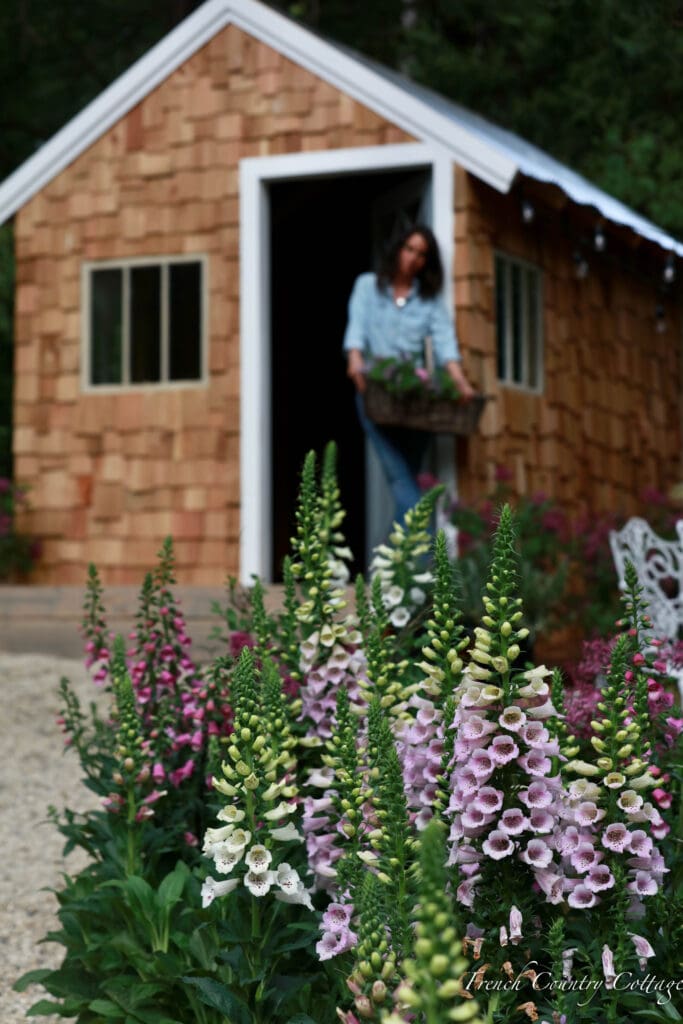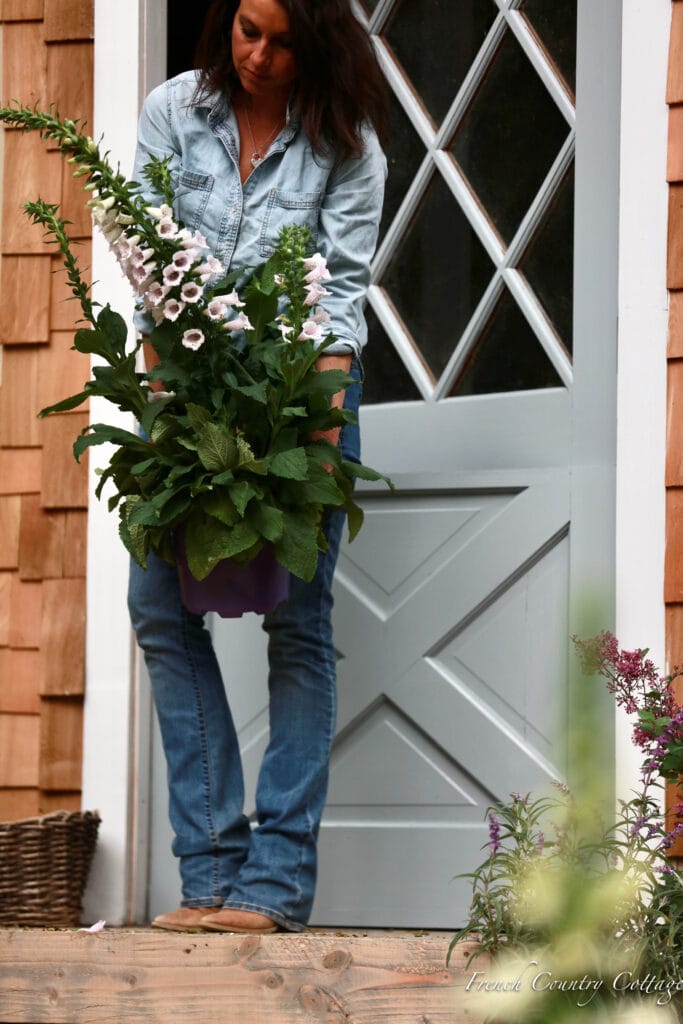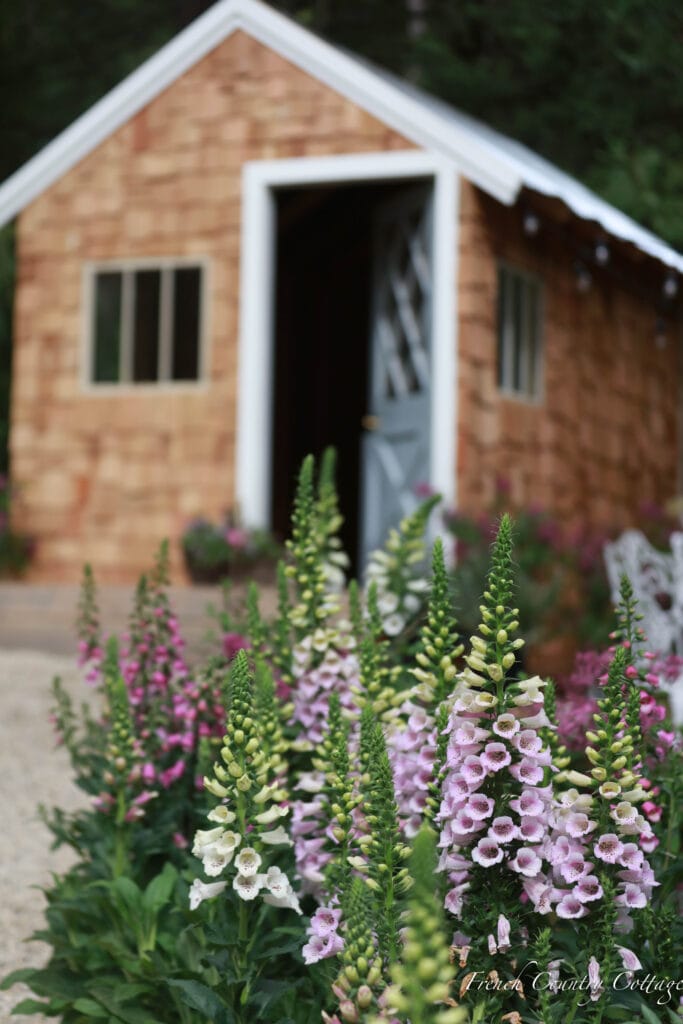Every time I share any photos of the garden – I get a ton of questions about foxgloves. How to grow them. Where to plant them. What types are they. Are they poisonous and how do you plant them to get them so full. And more. Though I have written before about Foxgloves- I thought I would answer some of those new questions along with the original post- and it is an every year share that gets updated since there is always so much interest.
Digitalis purpurea, which is what the common foxglove is named is native to Europe. The flowers are tubular, speckled (sometimes clear) and they bloom in shades of purple, rose, pink, apricot, yellow, white or sometimes bi-color as well. They grow well from seeds and will bloom for two to three months starting in late spring. They are biennial plants, which means foxgloves take two years to fully flower. And they are happy re-seeding plants-just let them dry and drop seeds in the garden – or a tip I heard recently was to cut the stalks and just lay them down in the garden and they will re-seed on their own that way too.
The curious case of the gophers… We added several new foxgloves to the garden a couple years ago and the next morning, we were surprised to see a couple of them wilting. We thought they maybe got shocked a bit or something like that- but when we checked- we found that the plant tops were completely off of the roots. Something had eaten the plant at the base and killed it. Which is pretty surprising actually- because foxgloves are known to be ‘resistant’ plants- meaning animals won’t eat them. They have come through and tackled all the allium overnight along with some of the bulbs that never grew in again- they were enjoyed as well. We have tried the wire cages. No luck there so we have since started planting the garden beds with plants in thin plastic pots in the ground that allow roots of the plant to grow through but not have them totally exposed to gophers who seem to like to eat foxgloves.
Foxglove is a beloved old fashioned perennial plant that makes a stunning addition to cottage gardens cutting gardens, and partial shade gardens. If you are looking to add some vertical interest and pops of color to your outdoor space foxglove is an excellent choice. With its spires of tubular flowers on tall stalks that can reach 5 feet tall, foxglove brings unique beauty to the garden.
In this complete guide, we will cover everything you need to know about where to find foxglove plants for your garden, including the best places to buy them.
Overview of Foxglove Plants
Before diving into where to purchase foxgloves let’s do a quick overview of this classic perennial plant.
Foxgloves, also known by their botanical name Digitalis, are biennials or short-lived perennials that are part of the Plantaginaceae family. Although the common name references foxes, it actually has nothing to do with those bushy tailed mammals. Instead, it refers to the old English word “folks” which sounded like “fox” and meant fairy.
So foxglove literally means fairy gloves, likely referring to the tubular flowers that resemble little gloves.
Some key facts about foxglove plants:
- Native to Europe, western Asia, and northwestern Africa
- Features long spires of tubular, bell-shaped flowers in late spring to early summer
- Flower colors include white, pink, purple, yellow, and red
- Attracts bees, butterflies, and hummingbirds
- Parts of the plant contain toxins and are not edible
- Deer resistant and rabbit resistant
- Does well in partial shade locations
Now that you know a bit about what makes foxgloves special, let’s explore the best places to buy these charming flowers for your garden.
Buying Foxglove Plants at Nurseries
Purchasing perennials like foxglove from local independent nurseries or regional nursery chains is a great option. You can see the plants in person, check their health, and get advice from knowledgeable staff.
The selection at nurseries may include a diverse range of foxglove varieties beyond just the common Digitalis purpurea. Some to look for include:
- Dalmatian series – spotted blooms
- Camelot series – extra tall with large flowers
- Sugar Plum – lavender-pink flowers
- Apricot – apricot blooms
- Strawberry – rose-pink flowers with spots
Nurseries will sell foxgloves in pots so you can plant them into your garden right away. The main downside to nursery shopping is limited inventory that sells out quickly. So visit early in the season for the best selection.
Ordering Foxgloves from Online Retailers
If you are looking for convenience or want access to a wider variety of foxglove plants, shopping with online retailers is the way to go.
Large retailers like Home Depot and Lowe’s have foxgloves available to order online and pick up at your local store. This allows you to shop from home but still get the plants quickly.
For the biggest selection of foxglove varieties, perennial specialists like Bluestone Perennials, Nature Hills Nursery, and Joy Creek Nursery are your best bet. Most offer free shipping on larger orders.
Another great option is to order from sites like Etsy and eBay where you can find unique foxglove plants from small independent nurseries and growers. This includes rare varieties not widely available elsewhere.
No matter where you choose to order foxgloves online, be sure to closely review shipping dates so your plants arrive at the optimal planting time for your region.
Buying Foxglove Seeds to Grow Your Own
If you enjoy growing plants from seed, starting foxgloves yourself is rewarding. You can find seeds for a wide variety of foxglove varieties from retailers like American Meadows, Seed Savers Exchange, Johnny’s Selected Seeds, and Baker Creek Heirloom Seeds.
Key benefits of starting foxglove plants from seed:
- Much more affordable than buying starter plants
- Access to unique heirloom varieties
- Can sow successive batches for blooms all season long
- Complete control over growing conditions
Just be aware that foxglove seeds need light to germinate so surface sowing and good soil contact is important. And they take 10-12 weeks to produce transplant sized seedlings.
So make sure to factor in the starting timeline when planning. You generally want to sow foxglove seeds 12-14 weeks before your last spring frost date.
Grow Foxgloves from Divisions or Cuttings
Another DIY option for getting foxglove plants for free is by taking divisions or cuttings from established plants.
Dividing foxgloves: In early spring or fall, you can dig up mature clumps of foxglove and divide them into smaller sections. Replant several inches apart and water well.
Taking cuttings: For quick foxglove propagation, take 4-6 inch tip cuttings from healthy plants in early summer. Remove the lower leaves and place in soil or water to root. Then transplant into the garden.
Dividing and taking cuttings allows you to multiply foxgloves already growing successfully in your landscape. Share with gardening friends too!
Where to Find Foxgloves: Key Takeaways
Foxgloves provide a touch of old world charm and vertical interest that are hard to beat in the garden. With their late spring to early summer blooming period, foxgloves are a delight.
To add these stately perennials to your own yard and gardens, you have lots of options:
- Shop at local nurseries for potted starter plants
- Order foxglove plants and seeds from online specialty retailers
- Grow your own foxgloves from seeds, divisions, or cuttings
Focus on getting foxgloves in the ground in early spring or fall. Take care not to disturb their taproot and give them rich, well-draining soil in partial sun to part shade. Then enjoy their beauty for years to come.

Foxgloves, People & Pets
A common question- are foxgloves poisonous? Yes they are. You don’t want to eat them of course, but some also say to also use caution when handling them. I have not had a problem with handling them but some might be sensitive. A few important tips:
Plant them away from edible garden plantings- Aka – Don’t include them in your veggie garden- their leaves look like edible leaves but are definitely Not.
Our chickens, goats and grands wander down the garden paths lined with foxgloves. But of course, we don’t let them wander here alone, we don’t leave them unattended and we don’t let them climb through the garden beds. On that same note- we have not had a problem with any animals eating or even going near them in the 20 or so years we have had foxgloves- even before we knew that they were poisonous. Until a couple of years ago with the moles or gophers eating the roots of them and killing the entire plant- which was very strange. We have since started planting them in cracked containers in the dirt in the garden beds- they seem to leave them alone and the roots can climb through enough to grow but not kill the plant if eaten.
Foxgloves in our Garden
We have planted several types of foxgloves in our garden. I am pretty much obsessed with almost all of them- but my favorite colors are whites, purples and peach. And so, those are the ones I load up on the most. While we found a huge amount of purples this year- we also lucked out with some white varieties and a couple ‘rose’ which is a darker pink color.

A favorite which we haven’t seen this year is peach. Peach Dalmatian or Apricot Beauty are gorgeous blushing peach colors. We have some planted from previous years but not in this area of the garden (yet!).

Some of the purples we found were a creamy pale purple color I believe it is called Camelot Lavender. In the sunset light- they appear to blush a bit – which is so pretty.
You can see the Dalmatian Purple mixed in this are as well- they are the more bold pink color and are the smaller foxgloves here. As you might have noticed- not all foxgloves are as big and tall as others.

We have several varieties of shades of White foxgloves as well. We did find a couple this year for the new area- as I mentioned – but we also have some that grew back from previous plantings. Something to note with foxgloves- the ‘spots’ on the inside can be dark or light- so depending on if you like the ‘speckled’ look- you can choose your foxglove type accordingly.
This is Dalmatian White- with the speckles.
And Camelot White- with lighter speckles.
They also have a more pure white Foxglove called Snow Thimble.
We also have a few Rose colored foxgloves. To be honest, these are ones that have grown back from several years ago so not sure just what variety they are but I think Dalmation Rose.
My husband recently found a very soft lemon color foxglove and we tucked a few into the garden this spring. I will update you on what they look like as they grow in and bloom fully. So far they look like they will be lovely.
My Experience with Foxglove! // Garden Answer
FAQ
When to buy foxglove plants?
Foxgloves are best planted in spring or autumn, when the soil is moist and warm, to encourage new root growth. If you buy a plant in flower in summer, plant it straight away, and take care to water regularly while it settles in, especially during hot, dry weather.
Does a foxglove plant come back every year?
Depending on where you live (your climate) and what variety of Foxglove you grow, they may perform as: an Annual (1 year life cycle), a Biennial (2 year life cycle), or. a short-lived Perennial (2-3 years)
Does Home Depot have foxglove plants?
2 Gal. Perennial Foxglove Plant 19658 – The Home Depot.
Are foxgloves poisonous to touch?
No, foxgloves are not generally poisonous to touch. While all parts of the foxglove plant are toxic if ingested, they are not typically harmful to the touch. According to Three Acre Farm, skin contact with foxgloves is generally safe.
Where can I buy foxglove perennials?
All you’ll need is sunlight, occasional water and just a bit of patience. Find Foxglove perennials at Lowe’s today. Shop perennials and a variety of lawn & garden products online at Lowes.com.
How big do foxglove plants get?
Foxglove plants can spead about 18 to 60 inches wide, depedning on the variety. To learn more about Foxglove and how to grow them check out our support page. Enhance the colors of your garden with Foxglove seeds and plants. These low-maintenance perennials thrive in sunny spots and bloom from late spring into late summer.
Are foxgloves a good plant?
Foxgloves provide plenty of it with their towering spikes, dense with trumpeted flowers in shades of pink—from coral to fuchsia—and distinct speckled throats. Low maintenance yet high impact, these biennials are a must-have for gardens that crave a little flair. Nice mix of flower colors for early season bloom. Blooms like crazy!
When do foxglove plants bloom?
Enhance the colors of your garden with Foxglove seeds and plants. These low-maintenance perennials thrive in sunny spots and bloom from late spring into late summer. Burpee
What is a foxglove flower?
Breakthrough crossing of isoplexis and digitalis. Blooms summer through fall. Foxgloves, a classic cottage garden favorite, are known for their striking, tall spikes of tubular flowers that range in shades of pink, coral, fuchsia, orange, and white.
What is a foxglove bred?
The first foxglove bred to bloom the first year. Foxglove cross with luminous reddish-orange flowers is a marvel of color and shape. Arctic Fox is a standout, with peachy centers and petals of the softest pink. Dramatic, towering spikes, dense with trumpet flowers. Breakthrough crossing of isoplexis and digitalis. Blooms summer through fall.
